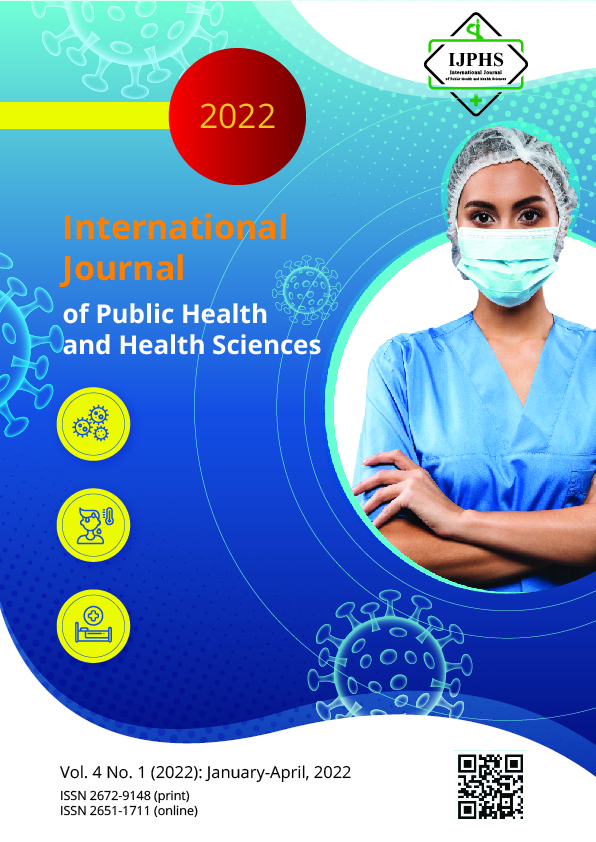Implication of Behavioural Change Theories in Occupational Health and Safety : A Systematic Review
Keywords:
Behavioural Change Theories, Occupational Health and SafetyAbstract
Background: Occupational health behaviour is a critical factor that influences work-related health problems and injuries. Thus, it is increasingly important that health providers incorporate understanding of the complexity of behaviour change into programmes designed to encourage and promote healthy behaviour among workers. Objective: The objective of this systematic review is to explore the uses of behavioural change theories in relevant studies regarding occupational health and safety and suggests applications to facilitate altering problem behaviours. Method: A search strategy was utilised the PICO model together with Preferred Reporting Items for Systematic Reviews and Meta-Analyses (PRISMA). Results: After the screening process based on inclusion and exclusion criteria, finally,18 studies were selected as the study selection. The theory of reasoned action (TRA) is commonly applied in occupational health research to investigate, explain, or predict individual intentions toward safety behaviours in a variety of different workplaces, while the theory of planned behaviour (TPB) was applied to investigate, explain, or predict individual intentions as well as perception of behavioural control toward occupational safety and health or to alter and improve different health behaviours in various kinds of workers. The transtheoretical model (TTM) is especially useful in developing programme or intervention. And finally, the health belief model (HBM) is useful for exploring perceived susceptibility, severity, benefits, barriers and self-efficacy, including cues to action towards self-protective behaviour. Conclusions: Health providers could apply these behavioural models in assisting employees to increase health promoting behaviours and, at the same time, conduct preventive interventions to minimise occupational injuries as well as work-related health problems.
References
Abdollahzadeh, G., & Sharifzadeh, M. S. (2021). Predicting farmers’ intention to use PPE for prevent pesticide adverse effects: An examination of the Health Belief Model (HBM). Journal of the Saudi Society of Agricultural Sciences, 20(1). https://doi.org/10.1016/j.jssas.2020.11.001
Ajzen, I. (1985). From Intentions to Actions: A Theory of Planned Behavior. In Action Control. https://doi.org/10.1007/978-3-642-69746-3_2
Ajzen, I. (1991). The theory of planned behavior. Organizational Behavior and Human Decision Processes, 50(2). https://doi.org/10.1016/0749-5978(91)90020-T
Ajzen, I., & Fishbein, M. (1980). Understanding attitudes and predicting social behaviour. New Jersey: Prentice-Hall. Englewood Cliffs, 50.
Bishop, A. C., Baker, G. R., Boyle, T. A., & MacKinnon, N. J. (2015). Using the Health Belief Model to explain patient involvement in patient safety. Health Expectations, 18(6). https://doi.org/10.1111/hex.12286
Consider the following clinical situations. (1995). Retrieved from http://ovidsp.tx.ovid.com/spa/ovidweb.cgi
DeJoy, D. M. (1996). Theoretical models of health behavior and workplace self-protective behavior. Journal of Safety Research, 27(2). https://doi.org/10.1016/0022-4375(96)00007-2
Didarloo, A. R., Shojaeizadeh, D., Gharaaghaji Asl, R., Habibzadeh, H., Niknami, S., & Pourali, R. (2012). Prediction of self-management behavior among iranian women with type 2 diabetes: Application of the theory of reasoned action along with self-efficacy (ETRA). Iranian Red Crescent Medical Journal, 14(2).
F., K., M., R., R., M., K., M., P., H., M.A., Z., … M., S. (2017). Effectiveness of an interprofessional education model based on the transtheoretical model of behaviour change to improve interprofessional collaboration. Journal of Interprofessional Care, 31(3).
Fishbein, M., & Ajzen, I. (1975). Strategies of Change: Active Participation. Belief, Attitude, Intention, and Behavior: An Introduction to Theory and Research.
Gao, L., Wang, S., Li, J., & Li, H. (2017). Application of the extended theory of planned behavior to understand individual’s energy saving behavior in workplaces. Resources, Conservation and Recycling, 127. https://doi.org/10.1016/j.resconrec.2017.08.030
Ginandhani, W. R., Kurniasih, D., & Rachman, F. (2021). A Model of Factors Affecting the Use of Personal Protective Equipment Using a Path Analysis among PLTU Contractor Workers in East Java. The Indonesian Journal Of Occupational Safety and Health, 10(1).
https://doi.org/10.20473/ijosh.v10i1.2021.137-143
Goh, Y. M., Ubeynarayana, C. U., Wong, K. L. X., & Guo, B. H. W. (2018). Factors influencing unsafe behaviors: A supervised learning approach. Accident Analysis and Prevention, 118. https://doi.org/10.1016/j.aap.2018.06.002
Gultekin, T., & Kitis, Y. (2019). Study for Development of Health Belief Scale Related to Lead Exposure. J Pub Health Issue Pract 3: 139. https://doi.org/10.33790/jphip1100139
Guo, Q., Johnson, C. A., Unger, J. B., Lee, L., Xie, B., Chou, C. P., … Pentz, M. A. (2007). Utility of the theory of reasoned action and theory of planned behavior for predicting Chinese adolescent smoking. Addictive Behaviors, 32(5), 1066–1081. https://doi.org/10.1016/J.ADDBEH.2006.07.015
Gupta, S. das, Fournié, G., Hoque, M. A., & Henning, J. (2021). Factors influencing chicken farmers’ decisions to implement prevention and control measures to reduce avian influenza virus spread under endemic conditions. Transboundary and Emerging Diseases, 68(1). https://doi.org/10.1111/tbed.13757
Hinsz, V., las, G. N.-R. de P. del T. y de, & 2015, undefined. (n.d.). The prediction of workers’ food safety intentions and behavior with job attitudes and the reasoned action approach. Elsevier. Retrieved from https://www.sciencedirect.com/science/article/pii/S157659621500016X
Jafaralilou, H., Zareban, I., Hajaghazadeh, M., Matin, H., & Didarloo, A. (2019). The impact of theory-based educational intervention on improving helmet use behavior among workers of cement factory, Iran. Journal of the Egyptian Public Health Association, 94(1). https://doi.org/10.1186/s42506-018-0001-6
Janz, N. K., & Becker, M. H. (1984). The Health Belief Model: A Decade Later. Health Education & Behavior, 11(1). https://doi.org/10.1177/109019818401100101
Keshmiri, F., Rezai, M., Mosaddegh, R., Moradi, K., Hafezimoghadam, P., Zare, M. A., … Shirazi, M. (2017). Effectiveness of an interprofessional education model based on the transtheoretical model of behaviour change to improve interprofessional collaboration. Journal of Interprofessional Care, 31(3). https://doi.org/10.1080/13561820.2016.1276051
Kuchi, M., Zare, M., & Aghamolaei, T. (2016). The effectiveness of “theory of planned behavior” in training the correct principles of manual material handling. International Journal of Environmental Health Engineering, 5(1). https://doi.org/10.4103/2277-9183.178770
Leandro-França, C., van Solinge, H., Henkens, K., & Murta, S. G. (2016). Effects of three types of retirement preparation program: A qualitative study of civil servants in Brazil. Educational Gerontology, 42(6). https://doi.org/10.1080/03601277.2016.1139969
Leiter, M. P., Zanaletti, W., & Argentero, P. (2009). Occupational Risk Perception, Safety Training, and Injury Prevention: Testing a Model in the Italian Printing Industry. Journal of Occupational Health Psychology, 14(1). https://doi.org/10.1037/1076-8998.14.1.1
Li, J., Zuo, J., Cai, H., & Zillante, G. (2018). Construction waste reduction behavior of contractor employees: An extended theory of planned behavior model approach. Journal of Cleaner Production, 172. https://doi.org/10.1016/j.jclepro.2017.10.138
Lopes, J. R. N., Kalid, R. de A., Rodríguez, J. L. M., & Ávila Filho, S. (2019). A new model for assessing industrial worker behavior regarding energy saving considering the theory of planned behavior, norm activation model and human reliability. Resources, Conservation and Recycling, 145. https://doi.org/10.1016/j.resconrec.2019.02.042
M M, H. S. (2010). Effect of education based on trans-theoretical model on promoting physical activity and increasing physical work capacity. Iranian Journal of Military Medicine Fall, 12(3), 123–130.
Ma, M., Yan, X., Huang, H., & Abdel-Aty, M. (2010). Safety of public transportation occupational drivers: Risk perception, attitudes, and driving behavior. Transportation Research Record, (2145). https://doi.org/10.3141/2145-09
Moazzami, Z., Dehdari, T., Taghdisi, M. H., & Soltanian, A. (2015). Effect of an Ergonomics-Based Educational Intervention Based on Transtheoretical Model in Adopting Correct Body Posture Among Operating Room Nurses. Global Journal of Health Science, 8(7). https://doi.org/10.5539/gjhs.v8n7p26
Moher, D., Liberati, A., Tetzlaff, J., & Altman, D. G. (2009). Preferred reporting items for systematic reviews and meta-analyses: The PRISMA statement. BMJ (Online), 339(7716), 332–336. https://doi.org/10.1136/bmj.b2535
Moradhaseli, S., Ataei, P., van den Broucke, S., & Karimi, H. (2021). The Process Of Farmers’ Occupational Health Behavior by Health Belief Model: Evidence From Iran. Journal of Agromedicine, 26(2). https://doi.org/10.1080/1059924X.2020.1837316
Nasir, E. F., Elhag, A. K., & Almahdi, H. M. (2020). COVID-19 Perceptional Disparity among Dental Healthcare Personnel at King Faisal University: Applying Health Belief Model. European Journal of Dentistry, 14, S56–S62. https://doi.org/10.1055/S-0040-1716782
O’Connell, S. E., Jackson, B. R., Edwardson, C. L., Yates, T., Biddle, S. J. H., Davies, M. J., … Munir, F. (2015). Providing NHS staff with height-adjustable workstations and behaviour change strategies to reduce workplace sitting time: Protocol for the Stand More at (SMArT) Work cluster randomised controlled trial Health behavior, health promotion and society. BMC Public Health, 15(1). https://doi.org/10.1186/s12889-015-2532-5
Orji, R., Vassileva, J., & Mandryk, R. (2012). Towards an Effective Health Interventions Design: An Extension of the Health Belief Model. Online Journal of Public Health Informatics, 4(3). https://doi.org/10.5210/ojphi.v4i3.4321
Özer, G., & Yilmaz, E. (2011). Comparison of the theory of reasoned action and the theory of planned behavior: An application on accountants’ information technology usage. African Journal of Business Management, 5(1), 50–58. Retrieved from http://ssrn.com/abstract=1923022http://www.academicjournals.org/AJBM
Pescud, M., Teal, R., Shilton, T., Slevin, T., Ledger, M., Waterworth, P., & Rosenberg, M. (2015). Employers’ views on the promotion of workplace health and wellbeing: A qualitative study. BMC Public Health, 15(1). https://doi.org/10.1186/s12889-015-2029-2
Prochaska, J. O., & DiClemente, C. C. (1983). Stages and processes of self-change of smoking: Toward an integrative model of change. Journal of Consulting and Clinical Psychology, 51(3). https://doi.org/10.1037/0022-006X.51.3.390
Prochaska, J. O., DiClemente, C. C., & Norcross, J. C. (1992). In search of how people change: Applications to addictive behaviors. American Psychologist, 47(9). https://doi.org/10.1037/0003-066X.47.9.1102
Research, D. D.-J. of S., & 1996, undefined. (n.d.). Theoretical models of health behavior and workplace self-protective behavior. Elsevier. Retrieved from https://www.sciencedirect.com/science/article/pii/0022437596000072
Rezaei, R., Seidi, M., Science, M. K.-S., & 2019, undefined. (n.d.). Pesticide exposure reduction: extending the theory of planned behavior to understand Iranian farmers’ intention to apply personal protective equipment. Elsevier. Retrieved from https://www.sciencedirect.com/science/article/pii/S0925753519300281
Rosenstock, I. M., Strecher, V. J., & Becker, M. H. (1988). Social Learning Theory and the Health Belief Model. Health Education & Behavior, 15(2). https://doi.org/10.1177/109019818801500203
Sanaeinasab, H., Saffari, M., Valipour, F., Alipour, H. R., Sepandi, M., al Zaben, F., & Koenig, H. G. (2018). The effectiveness of a model-based health education intervention to improve ergonomic posture in office computer workers: a randomized controlled trial. International Archives of Occupational and Environmental Health, 91(8). https://doi.org/10.1007/s00420-018-1336-1
Savari, M., & Gharechaee, H. (2020). Application of the extended theory of planned behavior to predict Iranian farmers’ intention for safe use of chemical fertilizers. Journal of Cleaner Production, 263. https://doi.org/10.1016/j.jclepro.2020.121512
Siponen, M., Adam Mahmood, M., & Pahnila, S. (2014). Employees’ adherence to information security policies: An exploratory field study. Information and Management, 51(2). https://doi.org/10.1016/j.im.2013.08.006
Suddin, Ks., Ani, M., Ismail, A., & Ibrahim, M. (2015). Investigation the Safety, Health and Environment (SHE) Protection in Construction Area. International Research Journal of Engineering and Technology (IRJET), 2(6).
Sutton, S., McVey, D., & Glanz, A. (1999). A comparative test of the theory of reasoned action and the theory of planned behavior in the prediction of condom use intentions in a national sample of english young people. Health Psychology, 18(1), 72–81. https://doi.org/10.1037/0278-6133.18.1.72
The Joanna Briggs Institute, 2014 - Google Scholar. (n.d.). Retrieved April 26, 2022, from https://scholar.google.com/scholar?q=The+Joanna+Briggs+Institute%2C+2014&hl=th&as_sdt=0%2C5&as_ylo=2014&as_yhi=2014
Wall, J. M. (2009). Development of a health-belief-model-based instrument to assess worker beliefs about using personal protective equipment. Retrieved from https://collections.lib.utah.edu/dl_files/79/75/7975a212671a98544047432929f8bb3c8e2a51be.pdf
Wright, T., Adhikari, A., Yin, J., Vogel, R., Smallwood, S., & Shah, G. (2019). Issue of compliance with use of personal protective equipment among wastewater workers across the southeast region of the United States. International Journal of Environmental Research and Public Health, 16(11). https://doi.org/10.3390/IJERPH16112009
Yousafzai, M. T., Siddiqui, A. R., & Janjua, N. Z. (2013). Health belief model to predict sharps injuries among health care workers at first level care facilities in rural Pakistan. American Journal of Industrial Medicine, 56(4), 479–487. https://doi.org/10.1002/AJIM.22117
Zare, F., Aghamolaei, T., Zare, M., & Ghanbarnejad, A. (2016). The Effect of Educational Intervention Based on the Transtheoretical Model on Stages of Change of Physical Activity in a Sample of Employees in Iran ASSESSMENT OF ATTITUDE TO SAFETY AND OCCUPATIONAL HEALTH AND OBSERVANCE OF THEM IN SCHOOL MANAGERS View project. https://doi.org/10.5812/jhealthscope.20126
Zeidi, I. M., Morshedi, H., & Zeidi, B. M. (2011). The effect of interventions based on transtheoretical modelling on computer operators’ postural habits. Clinical Chiropractic, 14(1). https://doi.org/10.1016/j.clch.2010.07.001
Downloads
Published
Issue
Section
License
Copyright (c) 2022 International Journal of Public Health and Health Sciences

This work is licensed under a Creative Commons Attribution-NonCommercial-NoDerivatives 4.0 International License.
If the manuscript is accepted for publication, copyright of the article shall be assigned to the IJPHS. After acceptance of a manuscript, the authors will be requested to complete a copyright transfer agreement form







